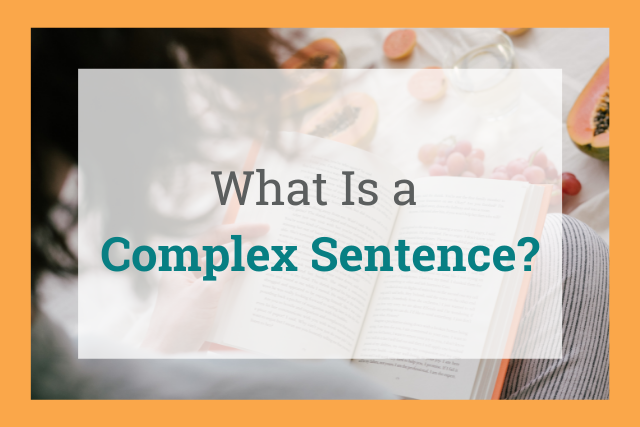
There are four categories of sentences: simple, compound, complex, and compound-complex. Each type of sentence has its own essential ingredients.
For the complex sentence, those ingredients are an independent clause and at least one dependent clause.
As you continue reading, I’ll show you how you can mix those two ingredients (the independent and dependent clauses) in different ways to whip up complex sentences.
What are Complex Sentences?
A complex sentence is a sentence that contains an independent clause and a dependent clause. Here’s an example of a complex sentence:
Because my pizza was cold, I put it in the microwave.
This sentence has an independent clause (“I put it in the microwave”) and a dependent clause (“Because my pizza was cold”) so it’s a complex sentence.
Before we get further into examples of complex sentences, let’s do a quick refresher on clauses.
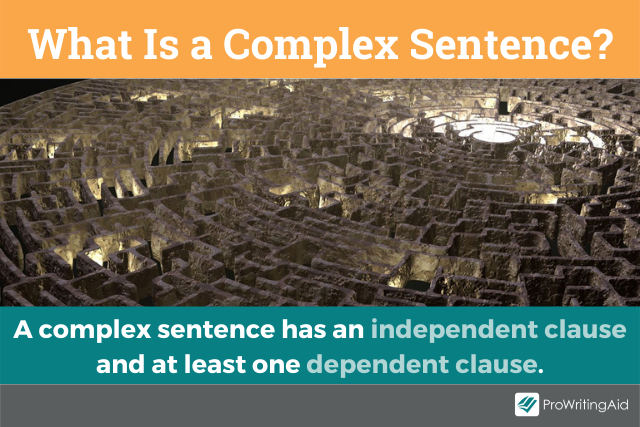
What are Independent and Dependent Clauses?
A clause is a group of words that contains a subject and a verb.
The difference between independent and dependent clauses is this: an independent clause can stand alone as a sentence and a dependent clause cannot.
What Is an Independent Clause?
An independent clause is a simple sentence. Those two terms, independent clause and simple sentence, mean the same thing.
An independent clause includes a subject and a verb, and expresses a complete thought—just like a simple sentence does.
An independent clause makes sense on its own. In these examples, the subjects and verbs are in bold.
- I had a rough start to my birthday today.
- I slept through my alarm.
- My boss was angry about my subsequent late arrival.
- Someone stole my lunch from the office fridge!
- No one even brought a cake to celebrate my birthday.
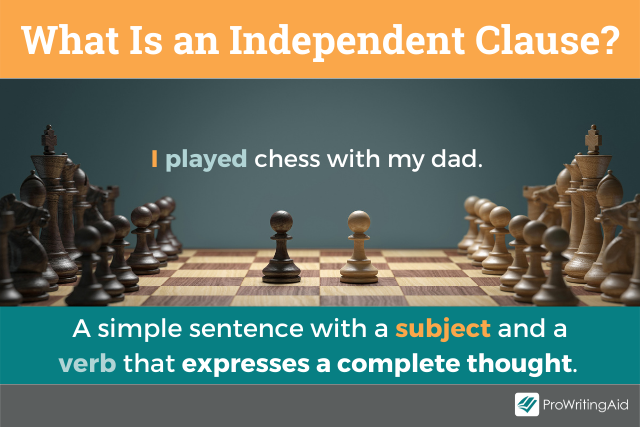
What Is A Dependent Clause?
A dependent clause also contains a subject and a verb, but does not express a complete thought.
It depends on connection to an independent clause to make sense. Another name for a dependent clause is subordinate clause.
A dependent clause often starts with a subordinating conjunction, a word which establishes a relationship between the information in the subordinating clause and the independent clause it is connected to.
These relationships include cause/effect, time, place, condition, comparison, and concession.
In these examples of dependent clauses, the subjects and verbs are in bold, and the subordinating conjunctions are highlighted.
- Because I left work late
- Since it was dark when I got back to my house
- While I was careful to observe my surroundings
- As soon as I opened the door
Did you notice the difference between these examples and the independent clauses?
With the independent clauses, we know what’s happening by the end of the sentence. This poor person, let’s call her Joanne, has had a lousy day.
With the dependent clauses, we are “left hanging,” and it seems as if Joanne’s day may have gotten even worse!
I wish we could find out if she at least got home safely on her forgotten birthday!
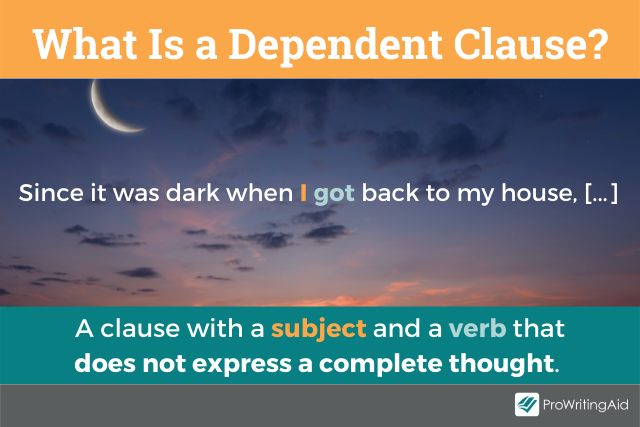
Actually, I think I have a solution. We can use those dependent clauses as one of the ingredients in our about-to-be-created complex sentences. Then we’ll get the complete story.
How to Create Complex Sentences
Complex sentences include an independent and at least one dependent clause.
Though the dependent clause cannot stand alone as a sentence, it does add to the meaning of the independent clause.
In a complex sentence, the independent and dependent clauses can be put together in a variety of ways. For example:
Dependent followed by independent: In this format, put a comma after the dependent clause.
- Because I left work late, I just wanted to get home and relax.
(The dependent clause tells us why Joanne wanted to get home)
Independent followed by dependent: In this format, no comma is needed.
- I was feeling extra stressed and tired since it was dark when I got back to my house.
(The dependent clause tells us why Joanne was extra stressed and tired)
Dependent both before and after independent: In this format, a comma is required after the first dependent clause.
- While I was careful to observe my surroundings, I almost tripped walking up to my door since I couldn’t see in the darkness.
(The dependent clause establishes a relationship of contrast with the independent clause)
Two dependents followed by an independent clause: In this format, put a comma after each dependent clause.
- As soon as I opened the door, and after I had kicked off my shoes, I had a sense that someone was in my house.
(The dependent clauses tell us when Joanne experienced that sense)
Do you see how those ingredients work together to create a complete thought?
While the independent clause doesn’t need the dependent clause to survive as a sentence, the dependent clause adds to the meaning of that dependent clause.
Here are a couple more examples to let you know what ultimately happened at the end of Joanne’s lousy day.
Take notice of their respective structures—the order of the independent (IC) and dependent clauses (DC), and where the commas (if needed) appear.
- I continued to walk down the hallway even though I was quite scared. (IC-DC)
- After letting out what I thought was an intimidating yell, I was greeted by five of my close friends yelling “Surprise!” (DC, IC)
- We all had a good laugh because of my lame attempt to scare away the “bad guys.” (IC-DC)
- Since my friends gifted me with a lovely surprise and chocolate cake, even though my birthday started out terribly, it ended in the best way possible. (DC, DC, IC)
Happy Birthday Joanne! To celebrate, I’ll show you one more way to structure a complex sentence.
Using A Dependent Clause to Interrupt an Independent Clause in a Complex Sentence
All the examples so far have shown complex sentences that include an independent clause and a dependent clause placed one after the other in one order or another.
But sometimes, a dependent clause can be put right in the middle of an independent clause. In this format, the dependent clause should be surrounded with commas.
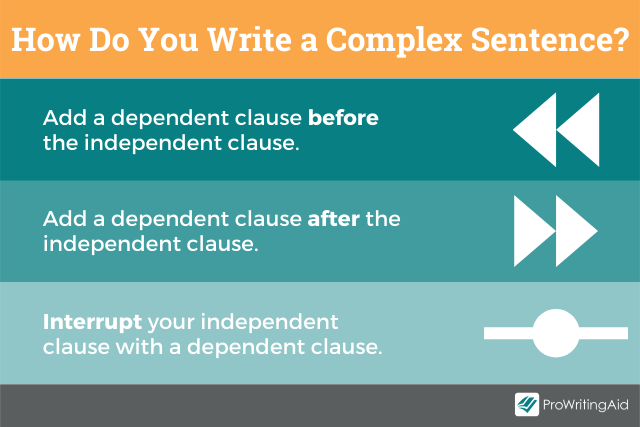
In these examples, the dependent clause is in bold. If you remove it from the sentence, you’re left with an independent clause.
- The dog, because he was so friendly, was adopted quickly.
- The meal, even though it was exceptional, was expensive.
- The students, whatever their skill levels, all showed improvement.
What’s The Difference Between Complex and Compound Sentences?
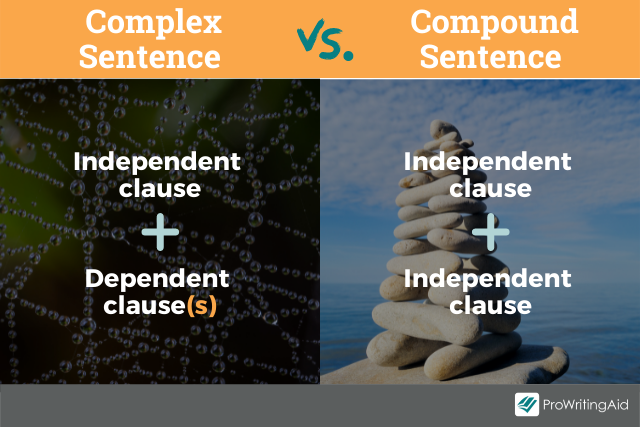
While a complex sentence includes an independent and at least one dependent clause, a compound sentence includes two independent clauses.
In a compound sentence, the independent clauses can either be joined with a semicolon or with a comma + coordinating conjunction combination.
Examples of Compound Sentences Using Semicolons
A semicolon has the combined power of both a period and a comma. It is strong enough to create a stop—a distinction—between two independent clauses, but is more gentle than a period.
The semicolon doesn’t create a full stop; it maintains a connection between the clauses, which is where you see its comma function.
You would use a semicolon when your independent clauses are closely related and you don’t want to create a full stop between them.
- I took a walk today; the fresh autumn air was invigorating.
- The leaves created a rainbow of colors; the foliage was enchanting.
- I returned home feeling both calm and energized; the beauty of nature is truly special.
Examples of Compound Sentences Using Coordinating Conjunctions + Comma
Coordinating conjunctions connect words, phrases, or clauses that are of equal value, such as two independent clauses.
Each of those clauses can stand on its own as a sentence.
The seven coordinating conjunctions are and, but, or, nor, so, yet, for.
A coordinating conjunction + comma combination has the power to connect—to hold together—two independent clauses.
A comma alone isn’t enough and produces an error called a comma splice.
In each of the following examples, the coordinating conjunction + comma combination is in bold.
- I ordered a salad ,but I really wanted a big bowl of spaghetti.
- The spaghetti smelled so good ,and I can’t stop thinking about it.
- I’m going back to that restaurant ,so I can order what I really want.
A compound sentence, unlike a complex sentence, only includes independent clauses. It does not include any dependent clauses.
What’s The Difference Between Complex and Compound-Complex Sentences?
The compound-complex sentence includes at least two independent clauses (remember: the complex sentence only has one) and one or more dependent clauses.
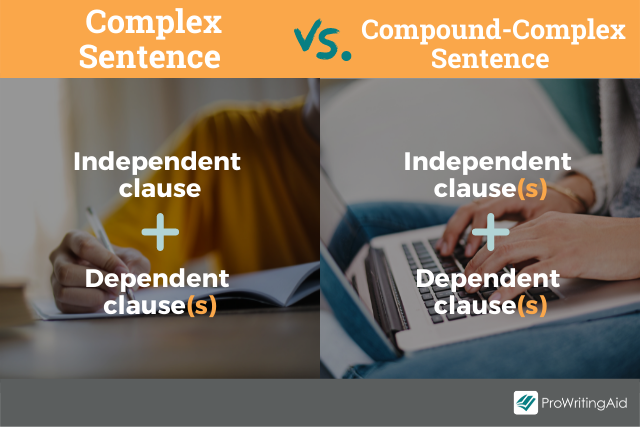
Examples of Compound-Complex Sentences
In these examples, the independent clauses are in bold.
- After I ordered my spaghetti, I felt happy, and I couldn’t wait to sit down and eat!
- I think I could eat pasta every day, even though I probably shouldn’t, and I would enjoy every bite.
- Because I want to eat healthy and since I’ve satisfied my craving, I’ll get back to salad tomorrow, but I’ll probably be back for more spaghetti before too long!
How Complex Sentences Help Your Writing
Adding variety to your sentence structure is important to good writing. If you rely too much on one style of sentence, your work will become monotonous and take on a droning effect. No one wants that!
By understanding how complex sentences work, you can add them to your work with confidence.
And if you need a boost for your confidence while you’re still practicing, run your work through ProWritingAid’s Sentence Structure Report.
It will help you see where your sentence structure may be repetitive and offer suggestions for how to add some variety.
Although the example below provides some really interesting details, the structure is repetitive, in fact, all the sentences start with a subject.
Including complex and varied sentence structures is essential if you want to keep your reader's attention.
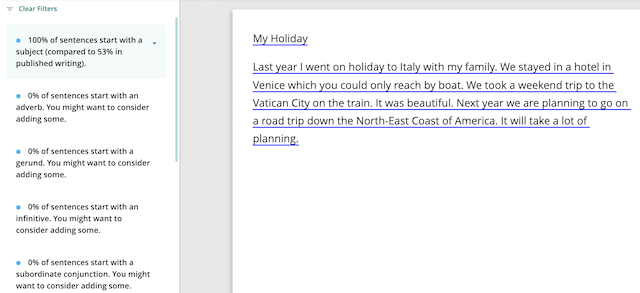
Try the Sentence Structure report with a free ProWritingAid account.
As a writer, it’s important to understand the tools of your trade. Sentence structure is one of those tools.
Take the time to notice how other writers use simple, compound, complex, and compound-complex sentences in their work.
Observe and learn as you read and then be inspired!


